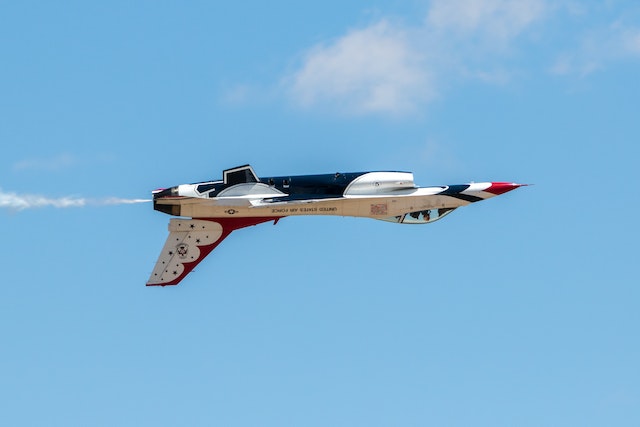
How can planes fly upside down? Because of the shape of their wings and the angle that they fly at.
Planes fly because of lift. Air is not an empty substance. It has molecules in the same way as a table or a chair. The air is made up of nitrogen, oxygen, carbon dioxide, neon, and hydrogen. It is mostly nitrogen. The only difference between the molecules in the air and the molecules in a table is that the molecules in air are spread out more and they are free to move. In the solid table, the attractive forces between the molecules hold them together. In the air, the kinetic force of each molecule is greater than the attractive force holding them together, which means they aren’t held in a solid shape and can move.
Air is a gas, but it acts as a fluid, which means that it flows. Because air is made up of molecules, it has pressure as well. When there are more molecules the air is denser and the pressure is high. When there are fewer molecules, the air is less dense and the pressure is low. Planes fly thanks to lift and that lift comes about because of a property discovered by Daniel Bernoulli in 1738. It is called Bernoulli’s principle and it states that as the speed of a moving fluid increases, the pressure within the fluid decreases.
Planes get their lift by directing the air over and under their wings at different speeds. The air flying over the wing moves as normal but the air going under the wing hits the front face of the wing and is forced down, slowing it. As Bernoulli said, the pressure decreases as the speed increases. The air moving over the wing moves faster and has a lower pressure. The air under the wing wants to move into the low pressure zone and moves up, lifting the plane with it. Planes also have flaps they can use to increase the length of the wing, increasing their lift.
However, this is not the only thing that gives lift. The wings on a plane are angled downward, which increases the amount of time it takes for the air to move under the plane. This is an easy experiment to replicate when you are travelling in a car. If you put your hand out of the window and hold it horizontally, it won’t move. If you angle your hand up or down, your hand will be forced up or down by the air pressure. This is how a plane flies.
So, how can a plane fly upside down? It comes down to the angle of attack. The wing of the plane is attached at an angle that will force the air down as it flies. To fly a plane upside down, the pilot just needs to make sure that the wing still has that angle of attack. When the plane is upside down, the pilot can push the nose down (up because the plane is upside down) and keep the wings at a high enough angle for the air to hit the front of them (the topside) and get slowed down. If the pilot can’t keep the nose like that, the plane will not stay upside down.
It sounds simple, but not all planes can fly upside down. Well, that is not true. All planes can fly upside down, but not all planes can keep flying upside down. Planes that are designed to fly upside down, such as aerobatic planes and fighter planes, have several differences to a regular plane. The first is the shape of the wing. Their wings are symmetrical. That means they are curved at the front on both the top and the bottom of the wing. That means, so long as they keep the right angle of attack, they can fly as easily upside down as rightside up.
The second difference is the engine. Most engines are designed to work with gravity. Gravity draws fuel out of the bottom of the fuel tank, along the pipes, and into the engine. Any plane can fly upside down, but its engine will stop working pretty quickly because it will run out of fuel. Even if there is still fuel in the pipes, the engine will seize up because the oil can’t flow either. Aerobatic planes use a fuel tank that has a weighted fuel line in it. When the plane is flying normally, the fuel line is at the bottom of the tank and when the plane is inverted, the weights make the fuel link sink with the fuel. They use a similar system for the oil as well.
The third difference with planes that are designed to fly upside down are the aileron spades. These are basically large stabilizers that are attached to the bottoms of the wings. They are attached to the ailerons and use the air pressure to help the pilots maneuver. They give the pilots a lot more balance when they are flying upside down. And this is what I learned today.
Sources
https://web.fscj.edu/Milczanowski/psc/lect/Ch4/slide2.htm
https://en.wikipedia.org/wiki/Bernoulli%27s_principle
https://www.grc.nasa.gov/www/k-12/UEET/StudentSite/dynamicsofflight.html
https://www.popularmechanics.com/flight/a19875/why-airplane-wings-angle-backwards-explainer/
https://www.cam.ac.uk/research/news/how-wings-really-work
https://www.sciencefocus.com/future-technology/how-are-some-planes-able-to-fly-upside-down/
https://www.smithsonianmag.com/air-space-magazine/how-things-work-flying-upside-down-27746739/
